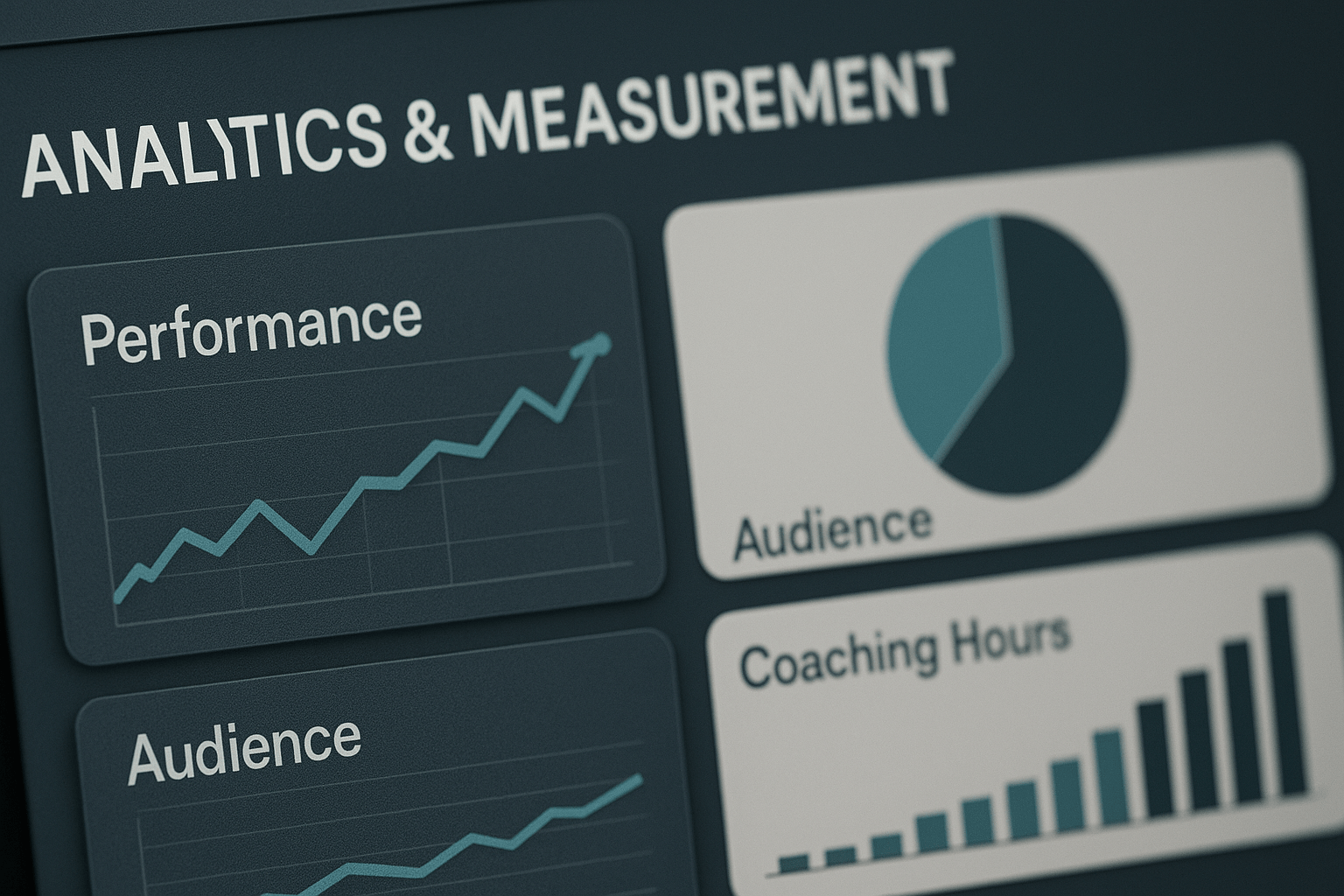No-Fluff Analytics & Measurement for Physical Therapy That Delivers
by Design Delulu Editorial · September 26, 2025

Physical therapy practices today face intense competition and evolving patient expectations. To thrive in this environment, you need more than just excellent clinical skills—you need data-driven insights that guide strategic decisions and measurable growth. This comprehensive guide explores how analytics and measurement can transform your physical therapy practice from reactive to proactive, helping you win more patients, improve outcomes, and drive sustainable revenue growth.

Why Analytics & Measurement Matter for Physical Therapy Practices
Smart, fast, and measurable approaches to analytics help physical therapy practices understand what's working, what isn't, and where opportunities for growth exist. Without proper measurement systems, you're essentially flying blind, making decisions based on gut feelings rather than concrete data about patient acquisition, retention, and satisfaction.
The modern physical therapy landscape demands precision. Patients research providers online, compare treatment outcomes, and expect transparent communication about their progress. Practice owners need visibility into marketing performance, patient journey optimization, and operational efficiency to stay competitive.

Key Benefits of Analytics & Measurement for Physical Therapy
Comprehensive Tracking Infrastructure
- Event + ecommerce tracking with GA4/server tagging: Monitor every patient interaction from initial website visit through treatment completion
- Source-of-truth dashboards in Looker Studio: Centralized reporting that eliminates data silos and provides clear visibility into practice performance
- Attribution modeling that matches your funnel: Understand which marketing channels drive the highest-value patients
- Governance for consistent, clean data: Establish protocols that ensure data accuracy and reliability across all touchpoints
Patient Journey Optimization
Modern analytics help you map the complete patient experience, from awareness through treatment and follow-up care. This visibility enables you to identify friction points, optimize conversion rates, and improve patient satisfaction scores.
Revenue Growth Insights
Track metrics that directly impact your bottom line, including patient lifetime value, treatment completion rates, referral patterns, and seasonal demand fluctuations. These insights inform capacity planning, service expansion decisions, and pricing strategies.

How Analytics & Measurement Works for Physical Therapy Practices
Phase 1: Discovery & Goals
The foundation of effective analytics starts with clarity. During this phase, we work together to clarify desired outcomes, identify constraints, and establish success metrics that align with your practice goals. This might include improving patient acquisition costs, increasing treatment completion rates, or optimizing scheduling efficiency.
Phase 2: Blueprint
Design the comprehensive strategy, technical architecture, and measurement plan tailored to your practice. This includes selecting appropriate tools, defining key performance indicators, and creating reporting structures that support decision-making at every level of your organization.
Phase 3: Build & Launch
Implement the analytics infrastructure, conduct thorough quality assurance testing, and deploy with robust tracking in place. This phase ensures all systems integrate seamlessly with your existing practice management software and electronic health records.
Phase 4: Optimize
Analytics is not a set-it-and-forget-it solution. Continuous iteration based on data insights allows you to double down on what's working while eliminating ineffective strategies. Regular optimization ensures your measurement system evolves with your practice.
Essential Deliverables for Physical Therapy Analytics
Comprehensive Tracking Plan
A detailed blueprint that outlines every metric, event, and conversion point relevant to your practice. This document serves as the foundation for all measurement activities and ensures consistency across team members.
GA4/Server-side Setup
Professional configuration of Google Analytics 4 with server-side tracking for enhanced data accuracy and privacy compliance. This setup captures patient interactions while respecting privacy regulations like HIPAA.
Custom Dashboards
Purpose-built reporting interfaces that present complex data in digestible formats for different stakeholders—from front desk staff monitoring appointment bookings to practice owners analyzing revenue trends.
Attribution Model Settings
Sophisticated systems that accurately credit marketing channels for patient acquisitions, enabling smarter budget allocation and campaign optimization.
Best Practices for Physical Therapy Analytics
Prioritize High-Impact Areas First
Focus initial measurement efforts on the highest-impact pages and patient flows. This typically includes appointment booking processes, insurance verification workflows, and treatment outcome tracking.
Integrate Creative with Measurement
Every marketing asset, from social media posts to patient education materials, should have associated key performance indicators. This approach ensures accountability and enables data-driven creative decisions.
Leverage Templates and Systems
Develop standardized reporting templates and measurement protocols that can scale as your practice grows. Consistency in data collection and reporting accelerates insights and reduces manual work.
Establish Regular Review Cycles
Implement weekly performance reviews for tactical adjustments and quarterly strategic assessments for longer-term planning. Regular review cycles ensure data insights translate into actionable improvements.
Industry-Specific Analytics Strategies for Physical Therapy
Map Search Intent to Patient Journey Stages
Physical therapy patients typically progress through distinct stages: pain recognition, provider research, initial consultation, active treatment, and maintenance care. Your analytics should track metrics relevant to each stage and identify optimization opportunities.
Leverage Social Proof and Outcome Data
Patients choose physical therapy providers based on trust and expected results. Use measurement systems to track and showcase patient testimonials, treatment success rates, and before-and-after outcome data early in the patient journey.
Maintain Single Source of Truth Reporting
Physical therapy practices often juggle multiple software systems—practice management, EMR, billing, and marketing tools. Consolidate this data into unified dashboards that provide comprehensive visibility without requiring manual data compilation.
Embrace Rapid Testing and Iteration
The healthcare landscape changes quickly, from insurance policies to treatment protocols. Your measurement approach should enable small experiments, fast testing cycles, and compound improvements over time.
Key Performance Indicators for Physical Therapy Practices
Revenue-Related Metrics
- Patient Lifetime Value: Average revenue generated per patient across their complete treatment cycle
- Cost Per Acquisition: Total marketing spend divided by new patient acquisitions
- Treatment Completion Rates: Percentage of patients who complete their prescribed treatment plans
- Revenue Per Visit: Average billing amount per patient appointment
Operational Efficiency Metrics
- Schedule Utilization: Percentage of available appointment slots filled
- No-Show Rates: Frequency of missed appointments by patient segment
- Average Treatment Duration: Typical length of patient treatment cycles
- Referral Conversion Rates: Percentage of physician referrals that become active patients
Patient Experience Metrics
- Net Promoter Score: Patient likelihood to recommend your practice
- Online Review Ratings: Average ratings across Google, Facebook, and healthcare-specific platforms
- Patient Satisfaction Surveys: Structured feedback about treatment experience and outcomes
- Website Conversion Rates: Percentage of site visitors who schedule appointments
Implementation Timeline and Expectations
Most comprehensive analytics and measurement implementations for physical therapy practices run 4–8 weeks, depending on the scope of work and feedback loops with your team. This timeline includes initial setup, testing phases, team training, and optimization based on initial data collection.
The first month typically focuses on infrastructure setup and data collection. Meaningful insights usually emerge in weeks 6–8 as sufficient data accumulates to identify patterns and trends. Ongoing optimization and strategic adjustments continue based on quarterly reviews and evolving practice goals.
Advanced Analytics Opportunities for Physical Therapy
Predictive Analytics for Patient Outcomes
Leverage historical treatment data to identify patients at risk of dropping out or requiring extended care. This enables proactive intervention and improved resource allocation.
Seasonal Demand Forecasting
Analyze historical patient volume patterns to anticipate busy periods, optimize staffing levels, and plan marketing campaigns around predictable demand fluctuations.
Referral Source Optimization
Track which physician referrals convert to long-term patients and generate the highest lifetime value. Use this data to strengthen relationships with top-performing referral sources.
Geographic Market Analysis
Understand patient travel patterns and identify underserved geographic areas where satellite locations or expanded services might succeed.
Getting Started with Physical Therapy Analytics
The key to successful analytics implementation lies in starting with clear goals and building measurement systems that grow with your practice. Begin by identifying your most pressing business questions—whether that's understanding patient acquisition costs, optimizing appointment scheduling, or improving treatment outcomes.
Focus on metrics that directly connect to revenue and patient satisfaction. While it's tempting to track everything, prioritizing a focused set of key performance indicators ensures your team can act on insights rather than getting overwhelmed by data.
Remember that analytics is an ongoing process, not a one-time project. The most successful physical therapy practices treat measurement as a core competency, investing in tools, training, and processes that support data-driven decision making at every level.
Measuring Success: What to Expect
Effective analytics and measurement typically produce measurable improvements within the first quarter of implementation. Common results include:
- 15-30% improvement in online conversion rates through optimized patient journeys
- 10-25% reduction in patient acquisition costs via better attribution and channel optimization
- 20-40% increase in patient lifetime value through improved retention and treatment completion
- Significant time savings through automated reporting and streamlined data collection
These improvements compound over time as your team develops greater analytical sophistication and your measurement systems capture more comprehensive patient journey data.
Conclusion
Analytics and measurement represent essential capabilities for modern physical therapy practices seeking sustainable growth and competitive advantage. By implementing comprehensive tracking systems, establishing regular review processes, and focusing on metrics that drive business results, practices can transform from reactive to proactive operations.
The investment in proper analytics infrastructure pays dividends through improved patient experiences, optimized marketing performance, and data-driven strategic planning. As the healthcare landscape continues evolving, practices with strong measurement capabilities will be best positioned to adapt, grow, and thrive.
Start with your most critical business questions, implement measurement systems that provide actionable insights, and commit to regular optimization based on data findings. Your patients—and your bottom line—will benefit from this analytical approach to practice management.
Let’s level up your Physical Therapy Analytics
Need analytics that actually moves the needle for physical therapy clinics? See our approach, pricing, and timelines—then book a quick call.
Related Resources
Additional Reading
- Local SEO for Physical Therapy: High-Impact Tactics That Win Now
- Marketing for Physical Therapy: High-Impact Tactics That Win Now
- Analytics & Measurement for Healthcare Practices: Complete Implementation Guide
Schedule a Consultation
Ready to implement analytics and measurement that drives real results for your physical therapy practice? Book a strategic consultation to discuss your specific goals, challenges, and opportunities for data-driven growth.